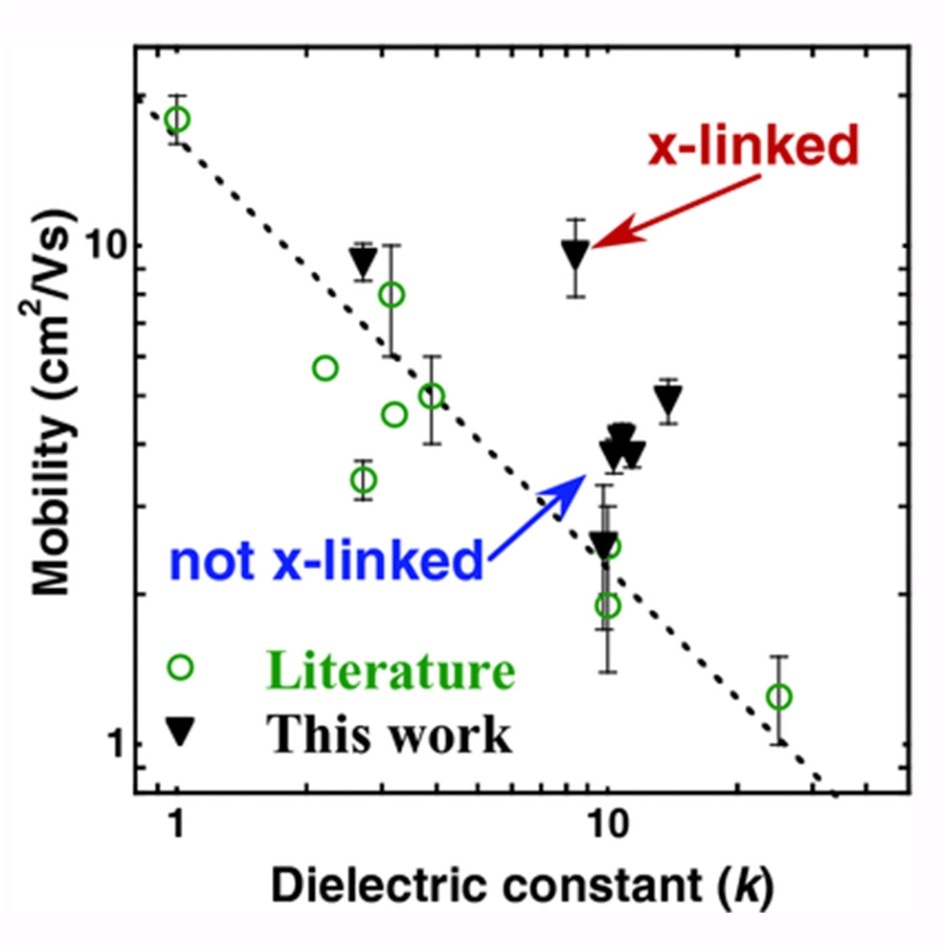Dec 2 2016
 A fluorinated polymer with a high dielectric constant is demonstrated within thin-film transistors. Crosslinking polymer chains reduces energetic disorder at the insulator–semiconductor interface, resulting in an increase in the charge mobility of rubrene single-crystal field-effect transistors. Credit: Enrique Gomez/Penn State.
A fluorinated polymer with a high dielectric constant is demonstrated within thin-film transistors. Crosslinking polymer chains reduces energetic disorder at the insulator–semiconductor interface, resulting in an increase in the charge mobility of rubrene single-crystal field-effect transistors. Credit: Enrique Gomez/Penn State.
A collaborative research carried out at Penn State demonstrated that fast and flexible electrical circuits can be developed by manipulating the twists and turns of fluorinated polymer chains. The outcomes of the research might open the door to the development of new polymer-type materials for flexible electronic applications.
Organic thin film transistors (OTFTs), an integration of organic semiconducting compounds with electronic components, have the ability to rapidly transform flexible electronics by creating bendable and foldable devices that can be used as electronic circuits.
Being the building blocks of highly complicated circuits, the OTFTs act as the “off” and “on” switches between different electronic states. They are formed of multiple layers, which include a dielectric layer that works as an insulator and induces charge.
Our work aims to introduce new, more stable polymers into electrical circuits without negatively impacting performance. By controlling the way that polymer chains twist and bend at a molecular level in OTFTs, we have found that we are able to break the universal relationship between charge mobility of the semiconductor and charge storage capacity of the dielectric layer, providing a basis to create fast and reliable circuits from organic materials.
Enrique Gomez, Associate Professor, Penn State
A study reported in Advanced Materials proposes that the relation can be broken mainly by manipulating the order and arrangement of polymer chains across the semiconductor interface.
Despite the fact that polymers have the ability to store huge amounts of electrical energy inside the insulator, it is well known that the electrical energy slows as it travels through semiconducting materials. Scientists are optimistic that new discoveries on the inverse relationship will open the door to develop fast organic devices with the ability to rapidly transform the field of flexible electronics.
Innovative chemistries formulated at Penn State inserted cross-linkable polymers into high-charge capacity chains, thus manipulating the arrangement of polymers.
Polymers can easily be imagined as long macromolecules that resemble spaghetti noodles. They either have the appearance of cooked spaghetti, where all of the chains are tangled and randomly entwined, or uncooked spaghetti, in which the chains are straight and neatly stacked, providing order along the backbone.
Enrique Gomez, Associate Professor, Penn State
When the polymer chains are crosslinked, the polymers are aligned along the insulating level of OTFTs, which leads to a reduction of charge traps - impediments or barriers along the insulator. This eventually leads to decrease in current leakage, generating highly efficient and faster circuits.
“We can think of charge traps as pot holes in the highway that electrons must travel over,” stated Gomez. “Decreasing the frequency of charge traps increases the speed in which OTFTs can switch on and off.”
For the purpose of this research, the scientists preferred to concentrate on fluorinated polymers (as it has high propensity to store energy and is exceptionally stable) as well as on transistors made from rubrene, which is an aromatic hydrocarbon.
The end results indicated that the mobility in OTFTs was increased by more than one order of magnitude - about 10 times - by cross-linked insulators. This increase was found to be greater than the mobility observed in rubrene single-crystal devices made with traditional insulators.
The researchers believe that the outcomes will pave way to the invention of new inexpensive materials for use in flexible electronic devices, which covers a multitude of applications such as wearable technologies, digital displays, health monitoring equipment, and so on.
Gomez’s collaborators in the research were fellow Penn State researchers Jwala Adhikari, primary author and recent Penn State chemical engineering PhD; Qing Wang, professor of materials science and engineering; Matthew Gadinski, graduate student in the Department of Materials Science and Engineering; Qi Li, postdoctoral fellow in the Department of Materials Science and Engineering; Thomas Jackson, Robert E. Kirby Chair Professor of Electrical Engineering; and Kaige G. Sun, a recent Penn State electrical engineering PhD
Additional collaborators were Alejandro L. Briseno, professor of polymer science and engineering at the University of Massachusettes, Amherst; Marcos Reyes-Martinez, postdoctoral research associate in Chemical and Biological Engineering, from the Princeton University; and Elissei Iagodkine, associate research scientist, Dow Chemical Company.
This research was funded by the Dow Chemical Company through a grant for the advancement of flexible and printed electronics at Penn State.